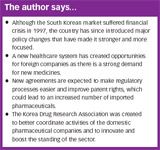New interest in an old market: South Korea
Pharmaceutical Technology Europe
Despite high ambitions for its pharmaceutical and biotech sectors, South Korea still faces a number of hurdles against competing internationally.
The last decade has seen considerable investment in South Korea, and the country now represents the world's 11th largest economy and has the 11th largest GDP.1 With a population of approximately 50 million and a GDP of $14000 (€8880) per head, it is an important consumer base that international companies cannot afford to ignore.

Faiz Kermani
Unfortunately, external enthusiasm for the South Korean market was severely dented by the 1997 financial crisis, which led to many foreign investors selling their assets. Since then, the country has introduced major policy changes that have made it stronger and more focused than other Asian competitors; for example, South Korea's foreign-exchange reserves have been described as the second highest after Japan among the 30 international member countries that make up the Organization for Economic Co-operation and Development. This makes the likelihood of another financial crisis reminiscent of 1997 unlikely.
As the country's economy has rebounded, so too has foreign interest. This was highlighted by the decision to hold the 2006 International Conference on Pharmaceutical Medicine (ICPM) in Seoul, South Korea's capital?— the first ICPM meeting to have been held in the Asian region.2
Driving foreign interest
The South Korean government has invested in infrastructure and improved funding for the healthcare system to alleviate uncertainties caused by the 1997 financial crisis, and to attract the attention of the global pharmaceutical sector. The National Health Insurance (NHI) Act, introduced in 1999, integrated multiple insurance societies into a single insurer system to enhance the equity of financing for healthcare. Backed by temporary measures through the 2002 Special Act for Financial Stabilization of National Health Insurance, the government attempted to provide comprehensive healthcare services to the public. The NHI system, overseen by the Ministry of Health and Welfare,3 is mandatory for Koreans living in the country, except for some medical aid beneficiaries. In October 2003, it was estimated that the NHI Programme covered 97% of the population. The Medical Aid Programme, a Korean social assistance programme, covered the remaining 3%.

The author says...
The new system has created considerable opportunities for foreign companies as there is strong demand from the population for new medicines. At present, pharmaceuticals account for approximately 30% of healthcare expenditure in South Korea.1 Estimates of the value of the country's pharmaceutical market vary, but Business Monitor International has predicted that it will reach $21.6 billion (€13.7 billion) by 2011.4
A major attraction for pharmaceutical companies is the separation of medical prescribing and dispensing, which was a key reform of the South Korean healthcare system in July 2000. This process marked a shift from dispensing doctors to a retail pharmacy market and was strongly resisted by physicians, who had traditionally derived a large proportion of their income from pharmaceuticals.
These measures appear to have benefited multinational pharmaceutical companies, which are dominating the market,1 and South Korean consumers are now more aware of branded medications. As foreign companies tend to introduce the latest breakthrough medicines, they have had the most success. In contrast, many local companies have become so reliant on income streams from the government for generic drugs that they have little desire to innovate.
Imports and innovation
In 2007, South Korea concluded a free trade agreement with the US that is expected to increase the number of US pharmaceutical products entering the country.4 The agreement should remove restraints on imports, make regulatory processes more transparent and is also expected to ensure adequate enforcement of pharmaceutical patent rights. In the past, there have been frequent complaints by foreign pharmaceutical companies because the South Korean pharmaceutical pricing system and procedures appeared to favour domestic companies.
However, the domestic pharmaceutical sector has been alarmed by these developments, particularly as additional agreements with Canada and the EU are expected to follow. In response, the South Korean Ministry of Health and Welfare announced it would invest $1.07 billion (€678.7 million) in the domestic sector during a 10-year period. Nearly 80% of this investment will be devoted to R&D initiatives, with the remainder being split between new infrastructure and assisting companies in exporting their products.4
Despite this pessimistic scenario, there have been moves to encourage innovation in the domestic pharmaceutical sector. The Korea Drug Research Association, a nonprofit organization established in 1986, aimed to better coordinate activities of the domestic pharmaceutical industry and boost its standing. The organization represents its member companies and promotes joint projects between industry and academic institutes.5 Additionally, it manages the Korea New Drug Award scheme to reward innovation, and has set up a pharmaceutical technology business centre to advise companies on technology transfer issues.
One of the major successes for the domestic industry was SK Chemical's 1999 local launch of Sunpla, a third-generation platinum complex anticancer drug.6 Another high point for the domestic industry was Daewoong Pharmaceuticals's 2001 launch of its epidermal growth factor, Easyef, for the treatment of diabetic foot ulcers. Easyef has been undergoing international trials and was recently launched in Jordan.7 The company hopes to license Easyef in the US, Europe and Japan, which would be a major boost for South Korean pharmaceutical companies.
Despite high ambitions for its pharmaceutical and biotech sectors, South Korea still faces a number of hurdles against competing internationally. As multinational pharmaceutical companies already have considerable experience in developing and launching drugs internationally, they are in an advantageous position compared with their emerging South Korean counterparts. Furthermore, their R&D budgets dwarf those of South Korean companies, which spend 4–6% of their turnover on R&D,1 whereas multinational companies often spend a double-digit percentage of their turnover on research.
Clinical trials
South Korea has become an R&D base, and many foreign and domestic companies are conducting clinical trials there. There are approximately 280 general hospitals in the country, and a pool of 83000 nurses and 75000 physicians.1 According to PRA International, the number of global clinical trials in South Korea grew substantially from only five in 2000 to 95 in 2005.8 The Clinicaltrials.gov database lists more than 700 clinical trials that include centres in South Korea.9 Most internationally sponsored trials are located in urban centres where there are English-speaking physicians,8 and some industry observers have predicted that the central nervous system therapeutic field will be a particular strong area for outsourced clinical trials in South Korea.10
South Korea is well suited for international studies after having adopted good clinical practice (GCP) in 1995 and then ICH-GCP in 2001.8 Furthermore, there has been an overt drive by the Korean Food and Drug Administration (KFDA) to improve transparency in the regulatory system and shorten time lines. Sponsors can now expect authorization within 30 days of receipt of the clinical trial application. The overall approval procedure in South Korea is further expedited because of the possibility of making parallel submissions to both the ethics committees and the competent authorities, with the import permit issued along with regulatory approval. Nevertheless, time must be allocated to ensure that the full Clinical Trial Application dossier is fully translated into Korean prior to submissions. At present, the KFDA plans to revise its regulations further to harmonize with international ICH guidelines to encourage sponsors to bring their global trials to the country.
Outlook
Improvements in the economy and continued investment in its healthcare system have once again sparked foreign interest in the South Korean pharmaceutical market. The market is currently dominated by foreign companies and all the signs are that this will continue. Furthermore, the country has attracted attention as a centre for R&D, particularly clinical trials. In the near term, domestic companies will find it difficult to compete with their foreign rivals.
References
1. UK Trade & Investment Biotechnology Sector Group, "The South Korean Biotechnology, Life Science and Pharmaceutical Industry" (2006). www.uktradeinvest.gov.uk
2. International Conference on Pharmaceutical Medicine (2006). www.icpm2006.org
3. South Korean Ministry of Health and Welfare, "The Social Security System of Korea. National Health Insurance Corporation" (2002). http://english.mohw.go.kr/index.jsp
4. Drug Researcher, "South Korea acts to save its pharma industry from US competition" (2007). www.drugresearcher.com
5. Korea Drug Research Association, "An Overview of the Korean Pharmaceutical Industry and Its R&D Activities" (2001). www.kdra.or.kr
6. SK Chemicals, "Sunpla: The First New Drug Developed in Korea" (2003). www.skpharma.co.kr
7. Daewoong Pharmaceutical Co., Ltd, "Easyef (Ingredient: EGF) With Excellent Effect Upon Treatment Of Chronic Injury And Scar Inhibition" (2005). www.daewoong.co.kr
8. Clinical Research in Taiwan, South Korea and Malaysia (PRA International, 2007) www.prainternational.com
9. Clinicaltrials.govwww.clinicaltrials.gov
10. Reuters, "What Pharmaceutical and Biotechnology Companies Want" (2008). www.reuters.com

PacBio Chosen as Tech Partner for Global Alzheimer’s Disease Research Project
April 23rd 2025The project, the North African Dementia Registry, will unite multiple entities for the purpose of developing a comprehensive dataset to advance the research community’s understanding of Alzheimer’s disease and other dementias in diverse populations.